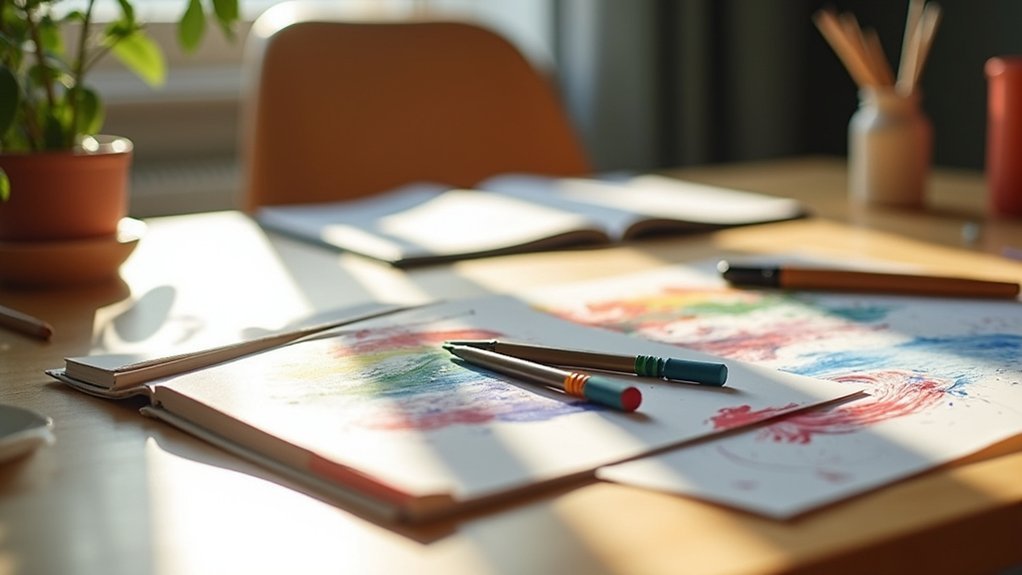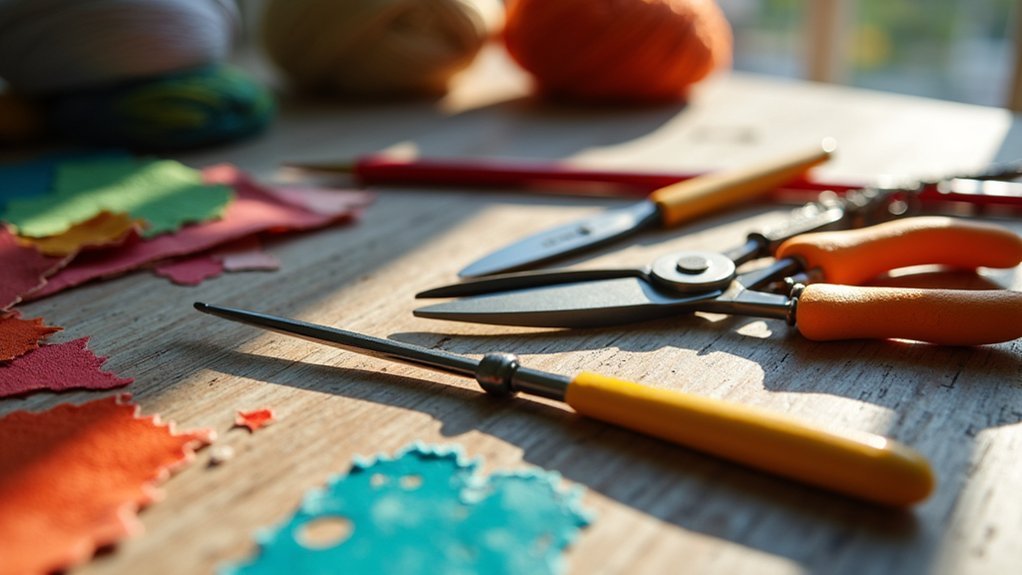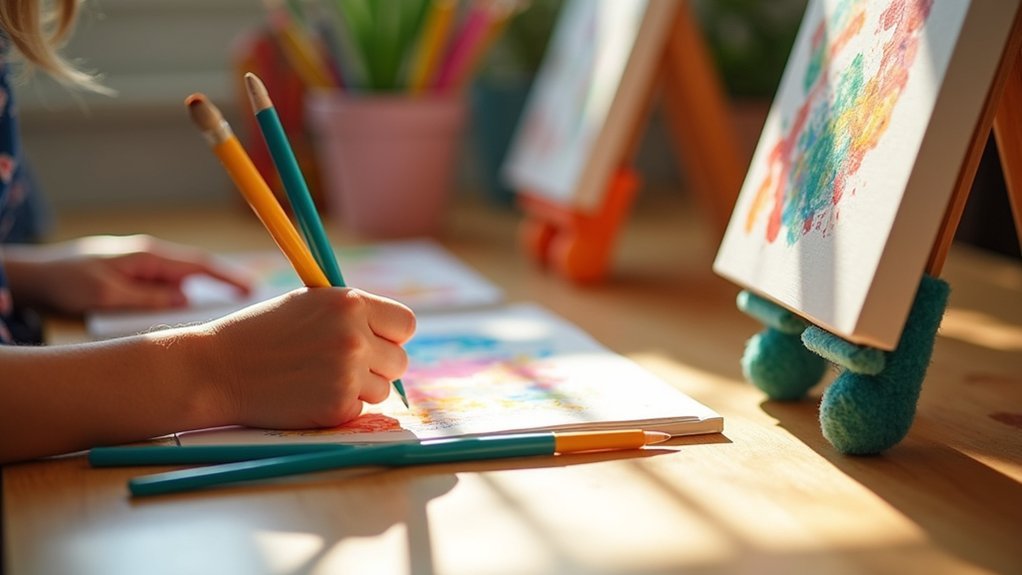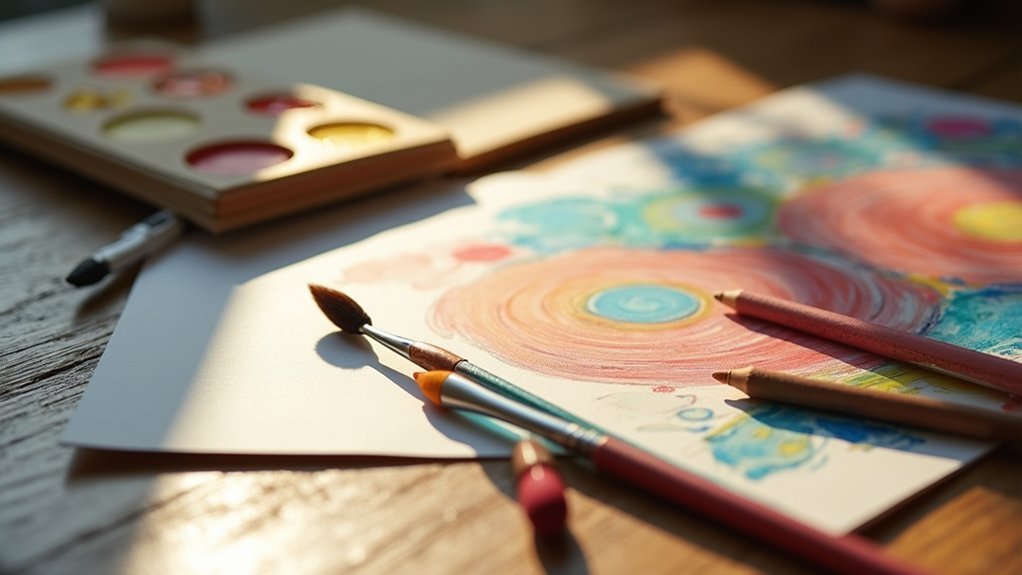Arthritis doesn’t need to limit your artistic expression. Look for tools with cushioned, larger grips that reduce joint strain—like ergonomic pens, foam brush handles, and spring-action crafting tools. Position your workspace at proper heights to prevent hunching, and consider adjustable easels or tabletop stands to maintain comfortable posture. Digital art apps and lightweight materials can also minimize physical demands while maximizing creativity. The right adaptive equipment transforms painful art sessions into enjoyable creative experiences.
Ergonomic Drawing and Writing Tools for Joint Pain Relief

While arthritis can make artistic expression challenging, specially designed ergonomic tools offer significant relief for those struggling with joint pain.
You’ll find writing aids with adaptive grips featuring larger, softer handles that reduce strain on inflamed joints.
Ergonomic pens are crafted to fit comfortably in your hand, minimizing pressure points and distributing force more evenly.
For drawing and painting, adjustable portfolios and easels help maintain proper posture, preventing unnecessary strain.
These specialized tools address common issues identified in workplace assessments, particularly fatigue and discomfort during creative activities.
Unlike general-purpose items, these tools are specifically designed for arthritis needs.
Studies show that appropriate ergonomic interventions can help individuals with inflammatory arthritis maintain productivity and continue their creative pursuits without exacerbating symptoms.
Adaptive Painting Equipment for Limited Hand Mobility
Expanding beyond basic ergonomic tools, artists with limited hand mobility can now access specialized painting equipment designed to overcome significant physical challenges.
Adaptive grips and assistive rings can transform standard brushes into user-friendly tools, while triangular handles provide natural stability without additional modifications.
For those with severely limited grip strength, consider taping brushes directly to your fingers or using weighted brushes to reduce tremors. Jumbo paintbrushes and modified handles require less fine motor control while maintaining artistic expression.
Your painting environment matters too. Wheelchair-accessible easels and height-adjustable tables create comfortable workspaces. DIY solutions like cutting pool noodles to create custom grips offer affordable alternatives to commercial products.
For digital artists, touch-sensitive apps and adaptive tablets offer creative freedom with minimal physical demand. Many resources like Zot Artz and Dick Blick now stock specialized adaptive painting equipment for artists of all abilities.
Specialized Tools for Fiber Arts and Crafting With Arthritis

For artists with arthritis who love fiber arts, specialized tools can make the difference between abandoning cherished crafts and continuing to create beautiful work.
Ergonomic options like cushioned crochet hooks, pre-warped loom kits, and chunky yarn with large needles reduce joint strain while maintaining creative expression.
When selecting fiber arts tools, consider these arthritis-friendly options:
- Utilize larger, blunt tapestry needles and magnetic pin holders to minimize pain during needlework projects.
- Choose acrylic or lightweight wooden knitting needles with thick shafts to reduce hand fatigue.
- Opt for spring-action jewelry pliers with cushioned handles when creating bead art to decrease required grip strength.
Polymer clay crochet hooks with soft grip handles offer excellent comfort and control for those with limited dexterity in their fingers.
You’ll find that hoop holders and weaving frames with adjustable tension can further customize your crafting experience to your specific mobility needs.
Workspace Modifications to Reduce Strain During Art Sessions
Creating art should be a joyful experience, not a painful one. Your workspace setup can make all the difference when managing arthritis pain during creative sessions.
Adjust table heights to prevent hunching over your work, and position frequently used materials within easy reach to minimize stretching. Invest in chairs with proper armrests for extended sitting periods, and keep your workspace clutter-free to prevent accidents.
Consider lighting carefully—use adjustable lamps to illuminate detailed work without causing eye strain. Take regular breaks to stretch and rest your eyes when focusing on intricate details. Implementing tools with large-grip brushes allows for comfortable handling while reducing joint strain.
Support your wrists with cushioned rests during repetitive motions, and secure materials to prevent shifting that might cause sudden movements or strain.
A well-designed workspace doesn’t just reduce pain—it enhances your creative flow.
Assistive Grips and Holders for Extended Creative Sessions

Five frustrating challenges plague artists with arthritis during extended creative sessions, but assistive grips and holders can transform this experience.
You’ll find various options like foam grips, egg-shaped handles, and silicone universal holders that reduce joint strain while providing comfort during your creative process. Products like The Pencil Grip offerings start at just $5.95 for a bag of 12 triangle grips, making them accessible for most budgets.
Effective grips feature non-slip surfaces, soft materials, and compatibility with different tools—from paintbrushes to crochet hooks. They’re available in multiple sizes to fit your unique hand shape.
Ergonomic grips combine cushioned materials with versatile tool compatibility, ensuring artists find the perfect fit for their hands and creative needs.
- Pain Relief – Users report significant reduction in arthritis and carpal tunnel pain
- Extended Creativity – Create for longer periods without excessive fatigue
- Renewed Independence – Regain control over your artistic expression despite mobility limitations
When selecting, prioritize adjustable sizing, soft materials, and grips endorsed by occupational therapists.
Frequently Asked Questions
Are Arthritis-Friendly Art Tools Covered by Insurance or Medicare?
Most insurance plans and Medicare don’t cover arthritis-friendly art tools unless they’re prescribed by a doctor for therapeutic purposes. You’ll need to check your specific plan or explore alternative funding options.
How Can I Adapt Art Tools for Children With Juvenile Arthritis?
You can adapt art tools by using easy-hold brushes, large-grip crayons, and adaptive handles. Try clay modeling, digital tools, and watercolors that require less pressure. Create comfortable workspaces with padded surfaces and proper seating.
Do Art Therapy Programs Provide Specialized Tools for Participants?
Yes, you’ll find that many art therapy programs provide specialized tools like jumbo brushes, ergonomic grips, and adaptive scissors. They’ll often assess your specific needs and customize tools to enhance your comfort and creative expression.
What Technologies Are Emerging for Voice-Controlled Art Creation?
Voice-controlled NLP tools are now interpreting your complex art commands with emotional context. You’ll find AI personalization adapting to your style while hands-free interfaces enable music composition, writing, and visual editing without physical interaction.
Can Certain Medications Improve Dexterity When Using Art Tools?
Yes, medications like dexamethasone in liposomal formulations can improve your dexterity when using art tools by reducing joint inflammation, decreasing pain, and preserving joint structure essential for the fine motor skills you need.
In Summary
Don’t let arthritis limit your artistic spirit. With the right adaptive tools and workspace setup, you’ll find renewed joy in creating. Remember to take breaks, listen to your body, and experiment with different options. Your creative journey doesn’t need to end—it’s simply evolving. Embrace these arthritis-friendly solutions and you’ll continue expressing yourself through art for years to come.





Leave a Reply